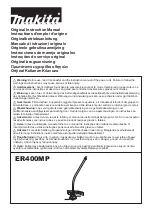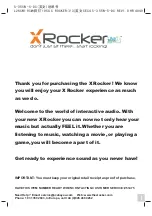
HELMET MAINTENANCE
The helmet protects your head, therefore it should be treated with care. It must be replaced if it receives a
heavy blow or if it is damaged following improper use. Furthermore, it must definitely be replaced in the
event of an accident however slight and even if it does not show any sign of damage. In fact any alteration
could make it ineffective. The visor too must be replaced if it is scratched. The helmet may also be seriously
damaged by some common substances without the damage being visible. Therefore, do not apply paints,
petrol or other chemical solvents to the helmet and follow the manufacturers instructions very carefully. Use
just water and neutral soap to clean the helmet and the visor. Do not leave the helmet exposed to the sun
or other sources of excessive heat (such as the motorbike silencer). Do not alter your helmet in any way. If
it is not suitable, replace it …. taking care to choose something better next time!
USING THE HELMET
Once you have chosen the most suitable helmet, it must be worn correctly: for your safety it is important to
fit the helmet properly on your head at all times and fasten the chinstrap securely.
5 things to be remembered at all times:
1.
Before using the helmet, make sure that you have read the instructions fully and that you have followed
all the recommendations for wearing the helmet properly.
2.
Do not use the helmet without fastening it. An unfastened helmet comes off at the first impact and
becomes completely useless.
3.
Do not fasten the helmet using just the Velcro. The Velcro is only provided to stop the chinstrap from
flapping.
4.
The helmet may deaden the sound of traffic. Make sure that you can hear sounds such as horns and
emergency sirens.
5.
To ensure the helmet guarantees optimum performance, never alter it in any way.
WHAT DOES A HELMET CONSIST OF?
1.
External shell: it is made of thermoplastic material or composite fibres.
2.
Internal shell: its purpose is to absorb the impact and it is made of expanded polystyrene. In the
event of an impact, even minimal, the shell will be damaged and the helmet must be replaced.
3.
Internal lining: usually it consists of expanded polyurethane combined with breathe-through, non-
allergenic fabric. Its purpose is to adapt the helmet to different sizes and to make it more comfortable
to wear. This inner lining is removable and washable.
4.
Air vents: they guarantee internal ventilation and, therefore, an air flow.
5.
Chinstrap. Two types are used: a double ring (DD), a rapid release system.
6.
Visor: it is made of transparent thermoplastic material and treated to be abrasion resistant (may also
have an anti-fog feature). It must be replaced when small scratches make night-time riding difficult.
Содержание N44
Страница 44: ...39 ...
Страница 109: ...104 66 ...
Страница 110: ...105 Eλληνικa 67 EÏÏËvÈÎ 67 EÏÏËvÈÎ Fig A ...
Страница 124: ...119 ...
Страница 125: ...120 Fig 6 Fig 1 Fig 2 Fig 3 Fig 4 Fig 5 ...
Страница 126: ...121 Fig 7 B A Fig 8 Fig 9 Fig 10 Fig 11 Fig 12 ...
Страница 127: ...122 Fig 14 Fig 13 Fig 15 Fig 16 Fig 18 Fig 17 ...
Страница 128: ...123 Fig 19 Fig 20 Fig 23 Fig 24 Fig 22 Fig 21 ...
Страница 129: ...124 Fig 26 Fig 25 Fig 29 Fig 28 Fig 27 1 2 ...
Страница 130: ...125 Fig 30 Fig 31 Fig 32 MIN MAX ...
Страница 131: ...126 Fig 33 ...
Страница 132: ...127 Fig 36B Fig 36A Fig 35B Fig 35A Fig 34A Fig 34B Fig 37 Fig 38 ...
Страница 133: ...ISTR000000087 12 2012 ...
Страница 135: ......
Страница 148: ...3 3 1 2 ...
Страница 149: ...cod 305103 09 2004 ...





































